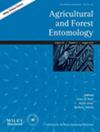Independent and interactive effects of diet and entomopathogenic microsporidia on an outbreaking forest insect defoliator
IF 1.8
3区 农林科学
Q2 ENTOMOLOGY
引用次数: 0
Abstract
Insect herbivore diet mediates interactions with entomopathogens, yet this is relatively unexplored for microsporidia. Here, we examine a diet‐mediated tri‐trophic interaction between an outbreaking forest defoliator, forest tent caterpillar (FTC) Malacosoma disstria Hübner and Nosema sp. microsporidia. We conducted two experiments where diet quality was manipulated by incorporating lyophilized aspen (Populus tremuloides Michaux) foliage into an artificial diet, which was compared to a standard artificial diet. Diet quantity varied between fully fed and partially starved conditions, simulating an outbreak scenario. Microsporidia infection occurred naturally or was induced via experimental inoculation. We assessed FTC survival, microsporidia infection and load, and sublethal effects of treatments on FTC traits. Plant secondary metabolite concentrations in aspen‐augmented diets varied between experiments. In Experiment 1, the aspen‐augmented diet contained lyophilized aspen foliage with low concentrations of secondary metabolites, which increased FTC survival and reduced microsporidia infection. Diet quality and infection load also interactively influenced adult wing traits in Experiment 1. In Experiment 2, the aspen‐augmented diet contained lyophilized aspen foliage with higher concentrations of secondary metabolites, which negatively affected FTC. No diet‐mediated interactions with microsporidia were observed in Experiment 2. Diet quality (Experiments 1 and 2), diet quantity (Experiment 2) and microsporidia infection (Experiments 1 and 2) directly influenced FTC survival and/or had sublethal effects on FTC that may have cascading effects on population dynamics and dispersal. We demonstrated that diet quality can mediate interactions between FTC and microsporidia, but these interactions depend on the defensive chemistry of the FTC diet. To our knowledge, this is the first study to report diet‐mediated interactions between an outbreaking forest pest and microsporidia and one of only a few studies to examine this tri‐trophic interaction among Lepidoptera.食物和昆虫病原微孢子虫对一种爆发性森林昆虫落叶器的独立和交互影响
昆虫食草动物的食性介导了昆虫病原体之间的相互作用,但对于微孢子虫来说,这一点还相对缺乏研究。我们进行了两项实验,通过将冻干杨树(Populus tremuloides Michaux)叶片添加到人工饲料中来操纵饲料质量,并将其与标准人工饲料进行比较。日粮数量在完全喂养和部分饥饿条件下变化,模拟疫情爆发的情景。小孢子虫感染会自然发生或通过实验接种诱发。我们评估了FTC的存活率、微孢子虫感染和负荷以及处理对FTC性状的亚致死效应。在实验 1 中,杨树添加的日粮含有冻干的杨树叶片,次生代谢物浓度较低,这提高了 FTC 的存活率并降低了微孢子虫的感染率。在实验 1 中,日粮质量和感染量也会对成虫翅膀特征产生交互影响。在实验 2 中,杨树强化日粮含有二次代谢物浓度较高的冻干杨树叶,这对 FTC 有负面影响。饮食质量(实验 1 和 2)、饮食数量(实验 2)和微孢子虫感染(实验 1 和 2)直接影响 FTC 的存活和/或对 FTC 产生亚致死效应,可能会对种群动态和扩散产生连带效应。据我们所知,这是首次报道爆发性森林害虫与微孢子虫之间由食物介导的相互作用,也是仅有的几项研究之一,研究了鳞翅目昆虫之间的这种三营养相互作用。
本文章由计算机程序翻译,如有差异,请以英文原文为准。
求助全文
约1分钟内获得全文
求助全文
来源期刊

Agricultural and Forest Entomology
农林科学-昆虫学
CiteScore
3.60
自引率
6.20%
发文量
66
审稿时长
>24 weeks
期刊介绍:
Agricultural and Forest Entomology provides a multi-disciplinary and international forum in which researchers can present their work on all aspects of agricultural and forest entomology to other researchers, policy makers and professionals.
The Journal welcomes primary research papers, reviews and short communications on entomological research relevant to the control of insect and other arthropod pests. We invite high quality original research papers on the biology, population dynamics, impact and management of pests of the full range of forest, agricultural and horticultural crops.
 求助内容:
求助内容: 应助结果提醒方式:
应助结果提醒方式:


